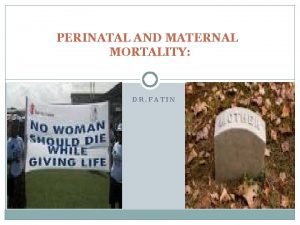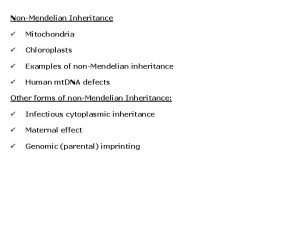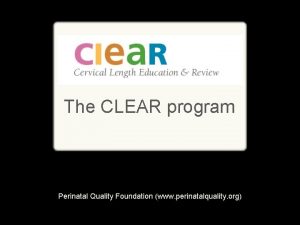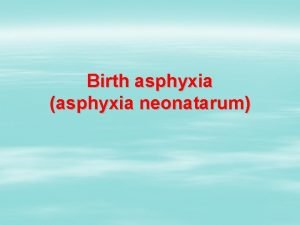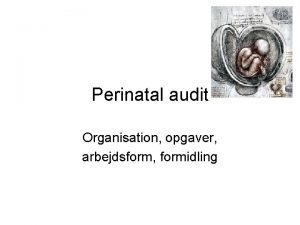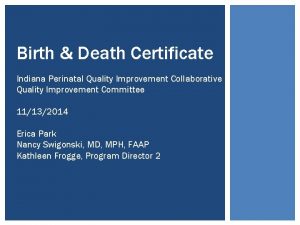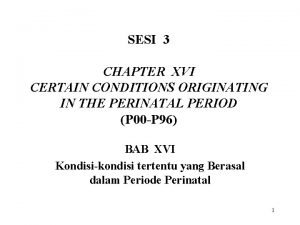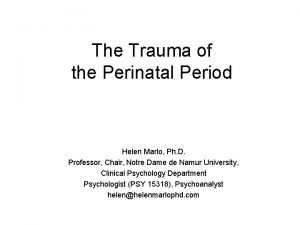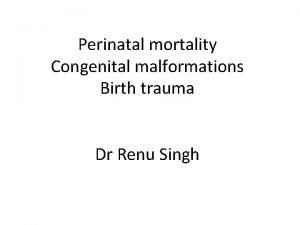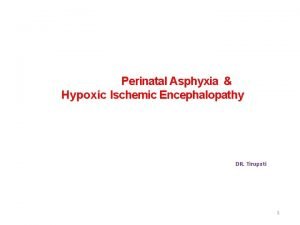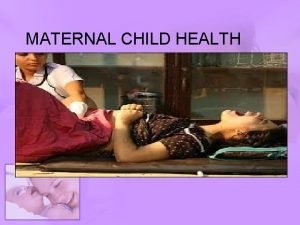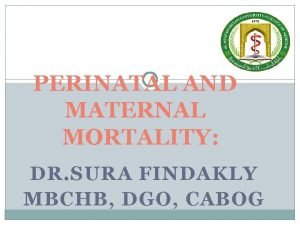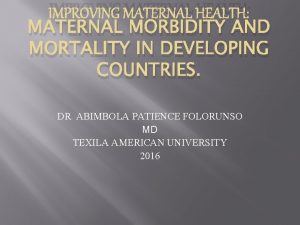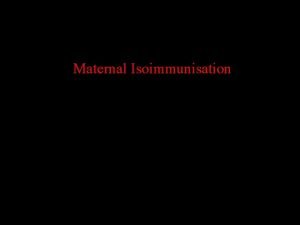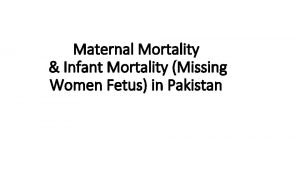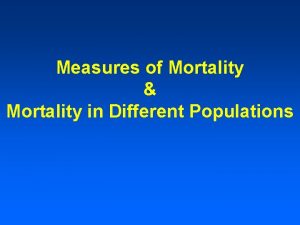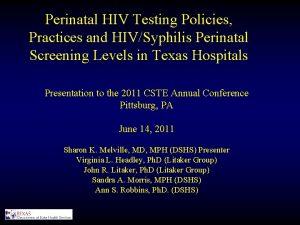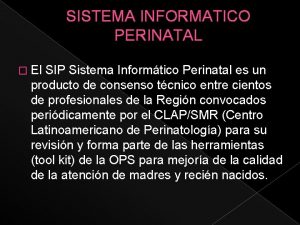Maternal and perinatal mortality Dr Malik Alqasem Mutah























- Slides: 23

Maternal and perinatal mortality Dr. Malik Alqasem Mutah university School of medicine 2019


INTRODUCTION • Mortality rates in the perinatal period are used to evaluate the outcome of pregnancy and monitor the quality of perinatal (prenatal and neonatal) care. The perinatal mortality rate encompasses late fetal and early neonatal mortality.

INTRODUCTION • About 287 000 women died in 2010 of complications during pregnancy or childbirth. • Most of these deaths can be avoided as the necessary medical interventions exist and are well known. • The key obstacle is pregnant women's lack of access to quality skilled care before, during and after childbirth

INTRODUCTION • Causes of maternal mortality • The major direct causes of maternal morbidity and mortality include: • The most common cause is VTE , , , others causes: • 1. Hemorrhage, • 2. Infection, • 3. High blood pressure, • 4. Unsafe abortion, • 5. Obstructed labour. •

INTRODUCTION • These complications may arise unexpectedly • Investing in health systems - especially in training midwives and in making emergency obstetric care available round-theclock - is key to reducing maternal mortality. • support women in seeking the needed care is 2 nd key

Definitions • The use of standard terminology facilitates comparisons of mortality rates among states and countries • A 2016 clinical report from the American Academy of Pediatrics (AAP) Committee on Fetus and Newborn established standard terminology for fetal, infant, and perinatal deaths, based on standards set by the World Health Organization (WHO) and the National Center for Health Statistics (NCHS) of the Centers for Disease Control and Prevention (CDC)

Definitions • The World Health Organization : • Live birth: Live birth is defined as complete expulsion or extraction from the mother of a product of human conception, irrespective of the duration of pregnancy. shows any evidence of life (heartbeats, umbilical cord pulsations, breathing, or voluntary muscle movement), regardless of whether the umbilical cord has been cut or the placenta is attached. Heartbeats should be distinguished from transient cardiac contractions and breathing distinguished from fleeting respiratory efforts or gasps.

Definitions The World Health Organization defines perinatal mortality as the number of stillbirths and deaths in the first week of life per 1, 000 total births, the perinatal period commences at 22 completed weeks of gestation, and ends seven completed days after birth. …… other Definitions

Definitions • Maternal death: death of a woman while pregnant or within 42 days from its end form causes related to or aggravated by pregnancy • Direct maternal death: death from obstetric complications • Indirect maternal death: death resulting from previous disease or disease developed in pregnancy but not caused direct obstetric causes • Late maternal death: death resulting from direct or indirect causes from 42 days to 1 year after delivery (end of pregnancy)

Maternal mortality The overall rate indirect deaths higher then direct causes The most common cause of direct cause is VTE Following by: Amniotic fluid embolism non significant increases in mortality rate from VTE , PET , eclampsia and sepsis comparing with hemorrhage and direct uterine trauma • The most common cause of indirect deaths is • Cardiac disease • • •

Risk factors • • • Social disadvantage Poor communities Late booking > 22 weeks Poor attendance Minority ethnic groups Obesity Domestic violence Substance abuse Substandard care



Recommendations • 1. Preconception counseling: for all women had serious medical or mental health conditions with clear plan for antenatal care , time of visits , mode of delivery • 2. the booking visit and held record should be completed by 12 weeks and with patient • 3. women under risk should be seen every 2 weeks • 4. full medical examination In first visit • 5. women with systolic BP >160 require treatment • 6. Caesarean : women should inform that CS not a risk free surgery •



Maternal mortality • Rate: • Number of maternal deaths in given period per 100 000 women of reproductive age during the same time period • • • Ratio: Ratio number of maternal deaths during a given time period per 100 000 live births during the same time period


Perinatal mortality • • • Causes: A. Antenatal causes: Maternal diseases HTN, CVD, DM, anemia , anatomical defect B. Intranatal causes: Birth injury, asphyxia, obstetric complications C. Postnatal causes: 1. Preterm delivery and low birth weight less than 2500 gr 2. neonatal infections 3. RDS 4. congenital anomalies

Prevention • • Antenatal prevention: Risk group women Prevent PTL Regular Antenatal care Screening and treat infections GBS screening ? ? Recommendations Treat maternal disease before pregnancy or control the diseases with pregnancy

Prevention • Intrapartum prevention: 1. Instrumental delivery by indications only 2. Risk group women 3. Delivery under well trained team 4. Treat Patients with infections 5. Antibiotics for GBS 6. Corticosteroids for PTL 7. Controlled ARM for polyhydroaminosis

Thank you • Thank You
 Perinatal mortality rate
Perinatal mortality rate Maternal effect and maternal inheritance
Maternal effect and maternal inheritance Extranuclear inheritance
Extranuclear inheritance Priya malik and tanu malik
Priya malik and tanu malik Mortality vs morbidity
Mortality vs morbidity Clear perinatal quality
Clear perinatal quality Grof perinatal matrices
Grof perinatal matrices Classification of birth asphyxia
Classification of birth asphyxia Neonatarum
Neonatarum Perinatal audit
Perinatal audit Uyarıcı zenginliği ve yoksunluğu nedir
Uyarıcı zenginliği ve yoksunluğu nedir Indiana perinatal quality improvement collaborative
Indiana perinatal quality improvement collaborative Certain conditions originating in the perinatal period
Certain conditions originating in the perinatal period Ccqi perinatal standards
Ccqi perinatal standards South dakota perinatal association
South dakota perinatal association Perinatal risk factors
Perinatal risk factors Perinatal period
Perinatal period Ruta materno perinatal
Ruta materno perinatal Waiter's tip deformity
Waiter's tip deformity Hie
Hie National programmes related to child health and welfare pdf
National programmes related to child health and welfare pdf Metaphase plate
Metaphase plate History of maternal and child health
History of maternal and child health Mch indicators full form
Mch indicators full form
